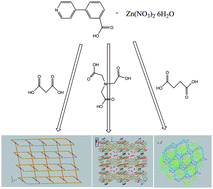Four dicarboxylic acids and nitrilotriacetic acid as secondary ligands have been used to tune the zinc(II)-organic frameworks constructed by an unsymmetrical pyridylbenzoate ligand, 3-pyrid-4-ylbenzoic acid (HL1). Interestingly, malonic acid (H2L2), nitrilotriacetic acid (H3L3), and succinic acid (H2L4), not coordinating to the metal centers and not even existing in the resultant coordination polymers can, however, tune the coordinating modes of L1 and zinc ions, and then the frameworks of their coordination polymers from interdigital 2D layers of [Zn5(L1)10(H2O)3.5]n (1), to porous 2D distorted square grids of [Zn(L1)2(H2O)1.5]n (2), and 4-fold interpenetrated 3D diamond networks of [Zn(L1)2]n (3), respectively. Especially, the topology of 1 displays an unprecedented (3,4)-connected 2D trilayer net with the Schläfli symbol of (62.8)2(6.84.10). For 2, there are 0.7 × 0.8 nm2 1D channels hosting water molecules. Besides, pimelic acids (H2L5) act as bridges for zinc dimeric constructing units and terminers for the 1D chain constructed by dimeric nodes and antiparallel double L1 spacers for [Zn2(L1)2(L5)]n (4). By contrast, terephthalic acids (H2L6) acting as bridges link similar 1D chains in 4 to construct interdigital 2D layers for [Zn2(L1)2(L6)]n (5). Finally, these five coordination polymers all exhibit strong fluorescent emissions at room temperature and high thermal stabilities.


 Please wait while we load your content...
Please wait while we load your content...